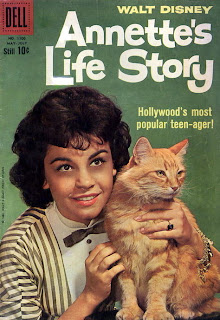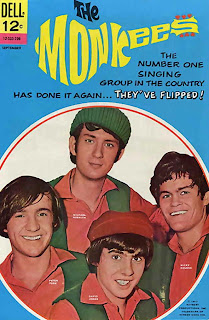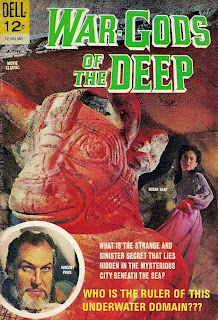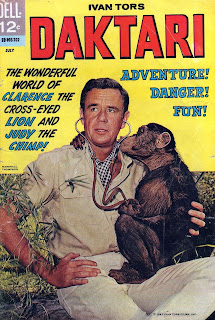Hello, my sweets. I must apologize for the long gap in between posts, but it's another typical maelstrom here in The Underworld. I've been polishing up the house for an appraisal, dealing with 101 issues and work and, though I haven't felt the need to announce it here formally, am about to re-emerge on to the local stage after a more than two-year, self-imposed absence, so there has been rehearsal four nights a week! That leaves only so much time for TV and movie viewing.
Now, I thought I had finally reached the saturation point on today's subject because I had already covered it here, here, here, here and here! However, I am still so enamored of these brilliant vintage comic book covers that I feel the need to point them out just one more time. They provide eye-catching, sometimes campy (as in the wigged-out, above left shot of Robert Wagner in one of his least fondly-remembered movie roles, that of Prince Valiant in 1954), conversation pieces and also give us, if not priceless, at least rare examples of publicity portraiture from classic TV shows and movies. While often the artwork inside is rudimentary and sub-par, the covers themselves are frequently delightful. Most of these blow up to a very nice size if opened in a new tab or window, btw...
One thing that's fun about these comics of the 1950s and '60s is that they gave fans of black and white TV shows (at a time when color TV sets were few and far between, even if a show happened to be in color!) the opportunity to see their favorite stars as they actually appeared. Take this amusing shot of the child stars of Leave It to Beaver (1957-1963.) I don't think anyone who loves that show could be disappointed with an item like this in their hands.
The hit western The Life and Legend of Wyatt Earp (1955-1961) couldn't pay full tribute to the charms of Hugh O'Brian without the addition of color.
Folks used to seeing Colt .45's (1957-1960) Wayde Preston only in black and white could view him (and his tuft of chest hair) in color.
Smirky-suave, charismatic James Garner of Maverick (1957-1962) looks better with some color in his cheeks, as does costar Jack Kelly.
Wook how young Steve McQueen is on this cover for Wanted: Dead or Alive (1958-1961.) Compared to what we later became used to in his movie career, he's a baby!
The trio of slender, good looking stars of 77 Sunset Strip (1958-1964) were never broadcast in color, but comic book covers showed them this way.
What more could you ask for? The covers also usually labeled each actor's name so that you would always knew who was who. Ed "Kookie" Byrnes was the breakout star of this show (and had been meant to be just a supporting player, really, at first), though his appeal has always escaped me almost completely!
A fan of The Untouchables (1959-1963) could get a peek at star Robert Stack's baby blues instead of seeing them gray as they appeared on TV. The role of Eliot Ness, which made Stack into a household name, was turned down by both Van Williams and Van Johnson prior to his being cast in it.
When The Andy Griffith Show debuted in 1960, red-haired Ronnie Howard was only seen in black and white and would be until it switched to color before leaving the air in 1968.
Burke's Law ran from 1963-1966, but was in black and white for its entire run (even though many shows made the jump to color around 1964 or 1965!
Perry Mason ran from 1957-1966 and, but for one special color episode, was also black and white throughout its run. (In this issue, Perry appears to be investigating a shooting at Sammy Davis Jr's house?)
Popular medical series Ben Casey began in 1961 in black and white, segueing into color before its cancellation in 1966. But comic books gave viewers some handsome color covers of star Vince Edwards long before the show had made the jump.
Former body-builder and physique model Edwards' had a brooding, handsome face, but his forearms also made quite an impression in his short-sleeved uniform tunic.
Think I'm kidding? Fur-lovers assemble! Check out these hirsute limbs jutting out from his shirt. Russell Johnson (the Professor of Gilligan's Island from 1964-1967) had auditioned to play Casey, but didn't win the part.
I suppose the most glaring example of a show being shot and broadcast in black and white, but which underwent a gargantuan difference in appearance once color was added is The Munsters (1964-1966.)
It can take some real getting used to, seeing Herman, Lily, Grandpa and Eddie this way when you've only seen them in their black and white incarnations.
This cover shows Pat Priest as Marilyn Munster. She replaced Beverly Owen after thirteen episodes. Incidentally, it was only the elaborate makeup that prevented Lost In Space's Billy Mumy from being Eddie Munster. His parents didn't want him to have to undergo that all the time. Had he taken the role, he likely would never have been cast in Space in 1965 as The Munsters was still running!
As color programs began to become commonplace, it was less unusual when comic readers saw the stars this way, but there were still many examples of fun, creative, colorful portrait art to grab the eye. Here, we see Robert Culp and Bill Cosby of I Spy (1965-1968), the first series to feature a black costar with equal billing and presence as the white one.
Look at this vividly-tinted photo of Leonard Nimoy of Star Trek (1966-1969.) Interestingly, the inset photo from the Enterprise bridge has Yeoman Rand in her nightgown! That's a shot from the Charlie X episode, which has no relation to the story told in this issue of the comic. (I believe I have posted this one before, but too bad!)
And here's a cute picture of the “twins” Buffy and Jody from Family Affair (1966-1971), with the others appearing courtesy of pasted-on insets. You can read more about the adorable, but highly tragic Anissa Jones here.
Vintage comics were sometimes devoted to various teen idols of the day. Here, we see pretty singer-actor Ricky Nelson, who had quite a few issues of this title featuring him. From age twelve and for the next fourteen years after, Nelson played a version of himself on The Adventures of Ozzie and Harriet (1952-1966)!
Our dearly-departed Annette Funicello was given the biographical treatment in her own comic book (with a strangely ghastly cover photograph... Lighting!!!) Is it “too soon” to say that I heard Walt Disney positively begged Annette not to pose on the cover of this publication with her pussy showing? (And stroking it, in fact!)
Even The Beatles were the subject of a comic book recounting their lives and massive success.
The back cover featured this (rare?) shot of the “Fab Four.” (The more I think about this, this may have been a magazine rather than a comic book, but I make my own rules down here, so I'm leaving it in just in case!)
Later, Bobby Sherman (singer and costar of the TV show Here Come the Brides from 1968-1970) took his turn in the teen idol limelight.
Hey, hey it's The Monkees, stars of their own musical comedy TV show from 1966-1968.
Fans of The Partridge Family (1970-1974) could read stories involving the television singing group inspired by the real life band The Cowsills. Look how young Danny Bonaduce was at this stage.
In time, David Cassidy emerged as the breakout star from that show and would have books devoted solely to him.
Hot shows with youth appeal often had comic book tie-ins. Here we see David McCallum and Robert Vaughn of The Man from U.N.C.L.E. (1964-1968.)
McCallum had legions of fans, but he never quite did it for me. He always seemed just a bit too much like Foghorn Leghorn's diminutive foil Egghead Jr., from the Warner Brothers cartoons....
Most of the covers for Bewitched (1964-1972) comics consist of fun and rare still photos of the principal cast and this one is no exception.
The Mod Squad (1968-1973) is another show that had several issues of a comic book in its honor. The cast looks positively thrilled to be there (though that was part of the series' “hook,” disenchanted young cops trying to make a difference.)
Did the cops of the very staid series Adam-12 (1968-1975) really ever take on a culprit as flamboyant as the illustrated one shown here??
I've mentioned in previous posts how sometimes these old comic books can offer up bits of camp. Having hit their stride in the 1960s, it would be hard not too (and why couldn't there have been a Valley of the Dolls comic book?!?! LOL) Here, we see a snidely villainous Vincent Price and a rather imposing statue from War-Gods of the Deep (1965.)
This cover has a lot going on! The Magic Sword (1962) was a really goofy, cheapjack Bert I. Gordon production, but at least provides some unintentional laughs and plenty of color.
This poor dear seems to have gotten even worse lighting than Annette Funicello above! Tales of Terror (1962) featured a trio of Edgar Allen Poe tales, all starring Vincent Price.
Alan Ladd (not playing a character, just Alan Ladd!) seems to have been an awfully busy guy back in the day in between film shoots...
I'm not sure that in these enlightened (or, at least, sexually heightened) times, a cover like this one featuring The Three Stooges would fly. There's a lot of wiener going on...
I think if I'd have purchased this title, “Soldier and Marine,” I might have been disappointed to get it home and find out that the stories inside involved war and not “piece.” Ha! (And could that possibly be Dana Andrews on the cover??)
As I've also covered in earlier posts, there were so many “one or two-shots,” comic adaptations of little-known movies or shows that are close to forgotten now. Who remembers the short-lived 1967 Tim Conway sitcom Rango?? I'd never even heard of it...
How about the 1969-1970 precursor to Lost, The New People? Actually, I wouldn't have minded getting to know one or two of these people a little better!
One of the zaniest, most bizarre Saturday morning kid's shows was Lidsville (1971-1973) about a boy lost in a land of talking hats! Recognize the young man on the cover? It's none other than a slightly more grown up Butch “Eddie Munster” Patrick!
How would you like to hum along with this comic strip adaptation of 1960's The Music Man?!
The 300 Spartans (1962) was also released as Lion of Sparta and the cover of the comic adaptation gave us a little thigh action from Richard Egan.
The inside back cover describes the Spartan lifestyle in brief, deftly (and appropriately, considering the target audience!) leaving out the speculation over organized homosexual behavior among Spartan soldiers and the FACT that athletics were practiced and performed in the nude!
Here, we see an adaptation of Journey to the Center of the Earth (1959), which costarred Pat Boone (who caused a bit of a lather here recently in a post about showers!) and 6' 4” blonde beauty Peter Ronson. Ronson was an Icelandic track star whose only film appearance came here.
This movie tie-in for Ensign Pulver (1964) might be focusing on star Robert Walker Jr (a dead ringer for his dad), but I'm far more captivated by the inset of shirtless sailors, one of which is divine Dick Gautier. I really need to see this movie......
While we've segued into the area of beefcake, I will take a moment to remind you all of the joys of Tarzan in the comics. I've explored this heavily before, but this is just a refresher! My own personal favorite Tarzan is tan, blonde Lex Barker.
For this era, he was in really great shape, which is to be expected if one is going to spend time in movie after movie wearing a teensy loincloth!
Gordon Scott was a cutie-patootie, too, though a burlier and more muscular Tarzan.
In this shot, he could just as well be playing Adam in a version of The Bible!
Ron Ely was a TV Tarzan, and much more slim by comparison, yet not without his charms.
Let's turn now to a tad of comic book crotchery. Ha! Nothing too crazy here, but I relay what I find... Appropriately enough, we begin with Dickie Jones, star of Buffalo Bill Jr (1955-1956.)
Like a lot of western actors, Jones was caught in action shots that sometimes allowed the camera to peer between his legs, not that anything obscene is going on. It's just fun.
Did you know that Mr. Jones provided the voice of the title character in Pinocchio (1940)? Well, now ya do!
This is Dale Robertson of Tales of Wells Fargo (1957-1962.) Robertson would later play Walter Lankershim in the first season of Dynasty.
Not necessarily known as a hunk, rugged-looking Richard Boone of Have Gun, Will Travel (1957-1963) serves up a little bulge (and some vividly blue eyes!)
The trousers on TV westerns became more and more tailored and snug from the '50s through the '60s and by the time of Lawman (1958-1962) were well on their way to being more eye-catching.
Is it just a fold in ol' Hank Fonda's pants in The Deputy (1959-1961) or did he forget to wear the jeweled jockstrap Joan Crawford gave him on the set of Daisy Kenyon back in 1947?!
The 1959 movie Rio Bravo teamed John Wayne and Dean Martin with Ricky Nelson, who was always packing more than a six-shooter. Don't believe me? Look here!
Lastly, Judy the Chimp of Daktari (1966-1969) seems to have found a particularly uncomfortable spot on Marshall Thompson for her to place her foot!
These types of tie-ins lessened considerably as the years wore on, with Happy Days (1974-1984) being one of the more notable remnants. (This is the third shot today of Ron Howard!)
Occasionally, a movie tie-in would pop up still, such as with The Black Hole or, in this case Flash Gordon (1980), which gave fans a chance to hold yummy Sam J. Jones in their hands (though his Playgirl photos were better, natch!)
Even now, comic books sometimes employ photo covers (recent examples have sprung from Buffy, The Vampire Slayer and Angel), though the glory days of the trend are over and have been for ages. I hope you enjoyed this (final??) stroll through them. I leave you with a hilarious cover featuring Lloyd Bridges of Sea Hunt (1958-1961), which unintentionally presages his later spoofy roles in Airplane! (1980) and Hot Shots (1991.) Don't forget to read the hysterical caption.
Wednesday, April 24, 2013
Subscribe to:
Post Comments (Atom)


































































0 comments:
Post a Comment